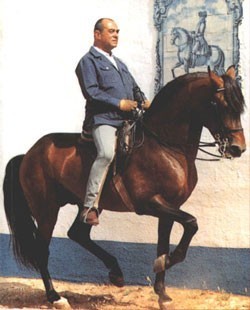
An equestrian statue as a tribute to the horseman Master Nuno Oliveira
“In life when two beings can get the most of themselves to achieve their best , something superb takes place.In this way in Art`itself it is necessary that the artist can be able to give the best of himself “. Nuno Oliveira
Being a part of the Horse National Fair Programme, on the 10th of November, at 17h00, in the Equuspolis, in Golegã, a lecture is going to take place and, its purpose is to promote the achievement of the supreme objective of building an equestrian statue to honour the horseman Master Nuno Oliveira.
For that purpose the horsemen who followed Nuno Oliveira`s equestrian Art are expected to be there to give their distinguished opinion related to the building of this monument .
If must be an equestrian statue with no political motivations, largely related to the contemporary culture and so it will encourage the knowledge and the pratice of the Master`s horsemanship .
The building of the new “ Museu dos Coches” in Lisbon according to the project of the remarkable Brazilian architect Paulo Mendes da Rocha, who won the Pritzker prize in 2006 , must include an equestrian statue ; it should be the image of the Portuguese homage to the Equestrian Art and no doubt it is internationally known that Master Nuno Oliveira (1925-1989) was a remarkable horseman of the 20th century , and so he actually deserves that homage.
Nuno Oliveira was a renowned sculptor of Portugal and he took to the world ,in the USA , Australia and in Europe a message of the beauty of the Equestrian Art and the contribution of the natural aptitude of the” Lusitano “ horse to this complex aesthetics culture .
The sculptor and horseman of well-known value in the Visual Art, Jean –Louis Sauvat ,a teacher of plastic Art at the “ École Nationale des Beaux-Arts “, had the chance to make acquaintance with Nuno Oliveira and he was even Oliveira´s student of the Art of riding ; Sauvat expressed remarkably Oliveira´s Equestrian Art what is shown in the work “ Propos sur des croquis equestres” printed by Belin . The study of these pictures of Sauvat makes us feel the Art of riding as a cultural activity in harmony with the contemporaneous naturalism.
It is the right place for this work of Art to be made with the contribution of a sculptor whose merit is internationally assumed and he will succeed in producing a monument to complete that work according to the excellent project already presented by the architect Paulo Mendes da Rocha. We are before the project of the 21st century first marvellous thing located in the highly historical Portuguese soil .Its size is estimated by an architect of great talent and international prestige to give an answer to the great amount of visitors who are supposed to observe the richness of that carriage collection and so it will no longer be concentrated in such small spaces ; the visitors can also see there some equestrian activities such as presentations of the Portuguese Equestrian School and so it will be a protitable investment on a cultural point of view and it can also maintain several aditional activities and even the tourism industry.
In the room of the new “ Museu dos Coches “must be included several works of Art and so it is completely justified an equestrian statue and the contribution of the sculptor Jean-Louis Sauvat will be very valious and it is a historical chance to get this contribution that can´t be substituted by any other.
Besides “ Oliveira was associated to the foundation of the Portuguese Equestrian Art School because its founders were students of his or his students `students “ as it is Marion Scali´ s opinion in the book “ Mestre Nuno Oliveira “. So it is largely justified the proximity of the Portuguese Equestrian Art School and the recognition of the teaching that inspired its foundation.
In order to cut in stone an equestrian statue representing a personality with the competence of Master Nuno Oliveira , it is necessary a sculptor horseman that has lived the Equestrian Art of the Master and has felt the harmony between the man and the “Lusitano “ horse ; these are Sauvat ´great qualities and besides that gift Sauvat possesses the international recognition of being one of the most remarkable sculptors devoted to the Equestrian Art.
The only sculpture representing Master Nuno Oliveira is a Delfim Maya´s work and he is also a sculptor- horseman , who knew and and interpreted Oliveira´s Equestrian Art , performing a pirouette on horseback , a statue made of plaster ( 40 cm x 48 cm x 48 cm ),that can be seen in José Malhoa Museum in Caldas da Rainha .
To understand the greatness of Nuno Oliveira´s Equestrian Art it is necessary the emotion that is possible to feel whenever we listen to a Verdi´s opera and speaking of Visual Art to discover on the back of a horse that feeling of pleasure and harmony that Nuno Oliveira taught and that Jean-Louis Sauvat knew how to show and make us feel in the several works of his authorship.
There are lots of books published about Nuno Oliveira´s Equestrian Art and their reading is the principal means of knowing it , today ; however what the writing language teaches us it is surpassed by the Visual Art when it reaches the expression of the beauty between the man and the horse in a communication with which some horsemen are gifted as it was the case of Nuno Oliveira; and he also had the quality of extending his feeling to his students. This is the qualified idea that Jean-Louis Sauvat can reach in his pictures and sculptures
